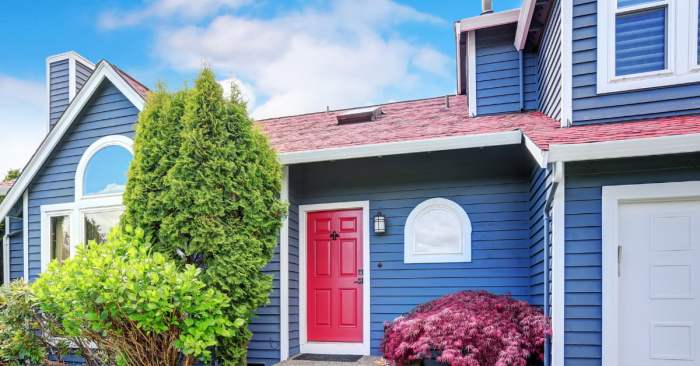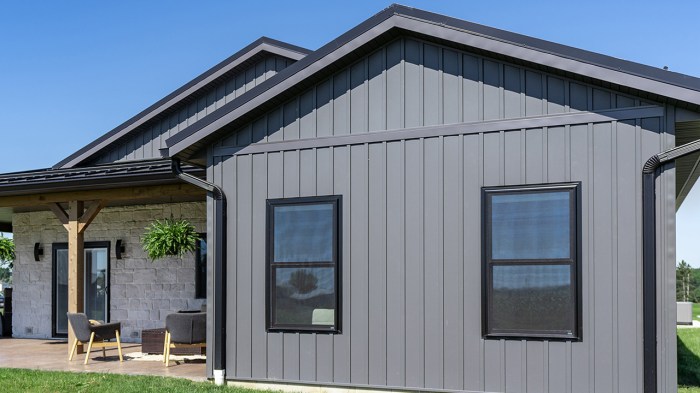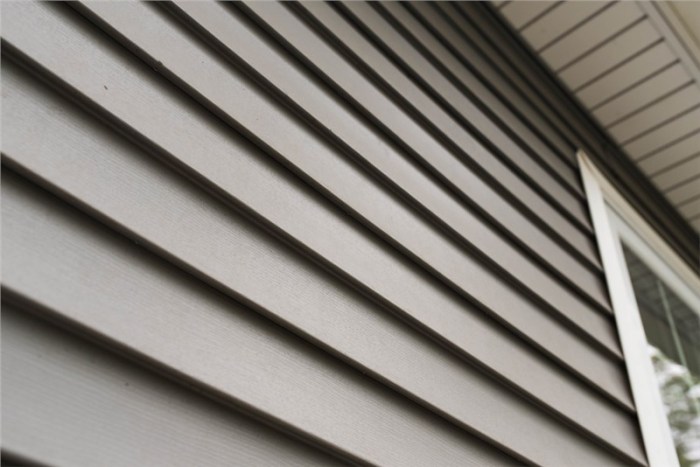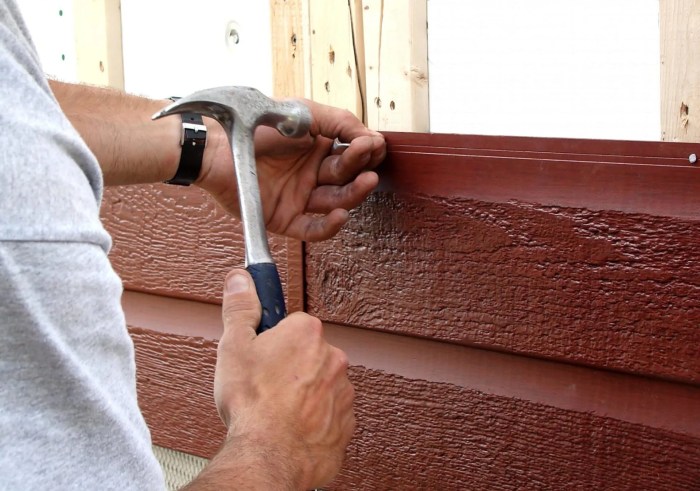Cost to Install Insulated Vinyl Siding

Cost to install insulated vinyl siding: Thinking about a new look for your home? Insulated vinyl siding offers a stylish and energy-efficient upgrade, but the cost can vary widely. This guide breaks down the factors that influence the price, from material choices to labor costs, helping you budget effectively and make informed decisions for your home improvement project. We’ll cover everything from material costs and contractor selection to potential hidden expenses and long-term savings.
Understanding the cost of insulated vinyl siding involves more than just the price of the materials. The project’s size, the complexity of your home’s exterior, the chosen siding quality, and even your location all play a significant role. We’ll explore these factors in detail, offering clear examples and cost comparisons to give you a realistic picture of what to expect.
Factors Influencing Installation Cost
Getting insulated vinyl siding installed is a worthwhile investment, but the final cost can vary significantly. Several key factors contribute to the overall price, and understanding these will help you budget effectively and make informed decisions. This section breaks down the major elements influencing the total cost of your project.
Material Quality
The quality of the vinyl siding directly impacts the cost. Higher-grade siding typically boasts thicker vinyl, enhanced durability, and more realistic wood-grain textures. These premium options often come with longer warranties and better resistance to fading, impact damage, and extreme weather conditions. Conversely, lower-grade siding, while less expensive upfront, might require replacement sooner, negating any initial cost savings in the long run. For example, a basic, entry-level vinyl siding might cost $2-$4 per square foot, while a premium, thicker, and more durable option could range from $6-$10 or more per square foot.
Labor Rates
Labor costs constitute a significant portion of the total installation expense. Regional differences in labor rates play a crucial role. Metropolitan areas with higher costs of living tend to have higher labor rates for contractors compared to rural areas. The contractor’s experience and reputation also affect labor costs; experienced and reputable installers often charge more, reflecting their expertise and the quality of their work. Expect to pay anywhere from $2 to $6 or more per square foot for labor, depending on these factors and the complexity of the job.
Regional Variations
Geographical location influences both material and labor costs. Transportation costs for materials, local regulations, and the prevailing market conditions in a specific region all contribute to variations in the final price. For instance, a project in a remote area might incur higher transportation costs, increasing the overall expense. Similarly, areas with a high demand for contractors may have higher labor rates due to increased competition.
Project Size and Complexity
The size of your house directly correlates with the amount of material needed, impacting the overall cost. Larger homes naturally require more siding, increasing both material and labor expenses. The complexity of the project also plays a significant role. Homes with intricate architectural details, multiple gables, dormers, or other features require more time and labor, leading to a higher final cost. Simple, rectangular houses with minimal features will generally be cheaper to build than those with elaborate designs.
Cost Comparison for Different House Sizes
The following table provides estimated costs for installing insulated vinyl siding on homes of varying sizes. These are estimates and can vary based on the factors discussed above.
| House Size | Material Cost (Estimate) | Labor Cost (Estimate) | Total Cost (Estimate) |
|---|---|---|---|
| Small (1000 sq ft) | $2000 – $6000 | $2000 – $6000 | $4000 – $12000 |
| Medium (1500 sq ft) | $3000 – $9000 | $3000 – $9000 | $6000 – $18000 |
| Large (2500 sq ft) | $5000 – $15000 | $5000 – $15000 | $10000 – $30000 |
Material Costs Breakdown
Getting a handle on the cost of insulated vinyl siding involves understanding the price of the different components. This breakdown will help you estimate the material expenses for your project, allowing for a more accurate overall budget. Remember that prices can fluctuate based on location, supplier, and the time of year.
The primary material costs consist of the siding panels themselves, the necessary trim pieces, and the fasteners used for installation. Let’s dive into a more detailed look at each.
Insulated Vinyl Siding Panel Costs
The cost of insulated vinyl siding panels is largely determined by the profile and color you choose. Simpler profiles, like a standard clapboard, tend to be less expensive than more complex designs, such as Dutch lap or shake styles. Similarly, popular, neutral colors are often cheaper than more unique or specialized shades. The thickness of the panel also plays a role; thicker panels generally offer better insulation and, consequently, a higher price tag.
- Standard Clapboard (Neutral Color): $1.50 – $3.00 per square foot
- Dutch Lap (Neutral Color): $2.00 – $4.00 per square foot
- Shake Style (Neutral Color): $2.50 – $5.00 per square foot
- Premium Color Options (Any Profile): Add $0.50 – $2.00 per square foot
These prices represent a range; actual costs can vary significantly depending on the specific manufacturer and retailer.
Trim and Accessory Costs
Beyond the siding panels, you’ll need various trim pieces to finish the job professionally. This includes J-channel, corner trim, starter strips, and window and door casings. These pieces are typically sold separately and can add a significant portion to your overall material costs.
- J-Channel: $1.00 – $3.00 per linear foot
- Corner Trim: $1.50 – $4.00 per linear foot
- Starter Strip: $0.50 – $2.00 per linear foot
- Window/Door Casings: Varies greatly depending on size and style; price is usually determined per piece.
Remember to factor in sufficient quantities of these items to avoid running short during installation.
Fastener Costs
While seemingly insignificant, the cost of nails and other fasteners should not be overlooked. High-quality fasteners are essential for a secure and long-lasting installation. The quantity needed will depend on the size of your project.
- Nails: A box of nails suitable for vinyl siding installation typically costs between $10 and $25.
Standard vs. Premium Insulated Vinyl Siding
The difference between standard and premium insulated vinyl siding is primarily in the materials used and the resulting durability and performance. Premium siding often uses thicker vinyl, better insulation, and enhanced color stability. This translates to a higher initial cost, but it may also offer a longer lifespan and better energy efficiency, potentially offsetting the extra expense over time. A direct comparison might show a price difference of $1-$3 per square foot, with premium options offering superior longevity and performance. For example, a premium siding might offer a 50-year warranty compared to a 20-year warranty for a standard option.
Labor Costs and Contractor Selection

Source: amazonaws.com
Getting new siding is a big investment, and a significant portion of the overall cost goes to labor. Understanding what influences labor costs and how to choose the right contractor is crucial for a smooth and budget-friendly project. This section will break down labor costs, helping you navigate the process of finding a reliable and skilled professional.
Factors Influencing Contractor Labor Costs
Several factors significantly impact a contractor’s labor costs. Experience plays a key role; highly skilled and experienced installers command higher hourly rates due to their efficiency and expertise in minimizing mistakes and ensuring quality workmanship. Their knowledge of proper installation techniques can also reduce material waste, indirectly lowering overall costs. Location also matters; contractors in high-cost-of-living areas typically charge more to cover their operational expenses and reflect the higher market value of their services. The complexity of the job, such as the size of the house, the number of obstacles (like windows and doors), and the need for specialized techniques, all influence the total labor time and, therefore, the cost. Finally, the time of year can influence pricing. Demand for contractors tends to be higher during warmer months, potentially leading to increased rates.
Hourly Rates of Different Contractor Types
Independent contractors often have lower overhead costs than large companies, which can sometimes translate to slightly lower hourly rates. However, large companies may offer more comprehensive warranties and have established systems for project management and insurance, potentially offsetting the initial price difference. A good rule of thumb is to compare multiple bids, considering not just the hourly rate but the overall package offered, including materials, warranty, and project timeline. For example, an independent contractor might charge $40-$60 per hour, while a larger company might charge $50-$80 per hour, though these are broad estimates and vary significantly based on location and experience.
Potential Hidden Labor Costs
While the hourly rate is a major factor, be aware of potential hidden costs. These might include charges for demolition and disposal of old siding, extra time required for unexpected repairs (like rotted wood under the siding), permits and inspections, and travel fees for contractors who are located further away. Always clarify these potential additions upfront to avoid unpleasant surprises. For example, removing old asbestos siding requires specialized handling and disposal, significantly increasing labor costs. Similarly, unexpected structural repairs, like replacing damaged sheathing, add considerable time and expense.
Finding and Vetting Reliable Contractors
Selecting a reputable contractor is vital for a successful siding installation. Follow these steps:
- Get Multiple Bids: Obtain at least three written bids from different contractors. Compare not only the total price but also the detailed breakdown of labor and materials.
- Check References and Reviews: Contact previous clients to inquire about their experience with the contractor’s work quality, communication, and adherence to deadlines. Online reviews on sites like Yelp or Angie’s List can also provide valuable insights.
- Verify Licensing and Insurance: Ensure the contractor is properly licensed and carries adequate liability and workers’ compensation insurance. This protects you from potential financial liability in case of accidents or damage during the installation.
- Review the Contract Carefully: Before signing any contract, carefully review all terms and conditions, including payment schedules, warranty information, and dispute resolution processes. Don’t hesitate to ask questions if anything is unclear.
- Meet the Contractor in Person: A face-to-face meeting allows you to assess their professionalism, communication skills, and attention to detail. This personal interaction can help build trust and ensure a better working relationship throughout the project.
Preparation and Additional Costs: Cost To Install Insulated Vinyl Siding
Getting your home ready for new siding involves more than just picking out the color. Proper preparation is crucial for a successful and long-lasting installation, and overlooking these steps can lead to unexpected expenses. This section will outline the costs associated with preparation and highlight potential additional costs that might arise during the project.
Preparing the exterior of your home for new vinyl siding often requires removing the old siding. This demolition process can vary in cost depending on the type of siding being removed (wood, aluminum, etc.), its condition, and the complexity of the home’s exterior. Removing asbestos-containing siding, for instance, will incur significantly higher costs due to the specialized handling and disposal requirements. Additionally, surface preparation, which includes cleaning, repairing damaged areas, and ensuring a smooth surface for the new siding, adds to the overall prep cost. The more extensive the repairs needed, the higher the cost will be.
Demolition and Surface Preparation Costs, Cost to install insulated vinyl siding
Demolition costs are typically calculated per square foot, and range from $1 to $5 per square foot, depending on factors mentioned above. Surface preparation costs are often included in the overall labor costs but can range from $0.50 to $2 per square foot depending on the extent of repairs needed. For a 1,500 square foot house, demolition might cost between $1,500 and $7,500, while surface preparation could add another $750 to $3,000. These costs can be significantly higher for homes with complex architectural features or extensive damage to the existing siding.
Unexpected Repairs and Material Waste
Unexpected repairs are a common occurrence during siding projects. Discovering rotted wood under old siding, damaged sheathing, or insect infestations requires additional time and materials, increasing the overall project cost. Similarly, material waste can occur, especially with complex designs or challenging installation areas. Accurate measurements and careful planning can minimize waste, but some level of waste is usually unavoidable. A contingency budget is crucial to account for these unexpected situations.
Checklist of Potential Additional Costs
It’s wise to create a budget that includes potential additional expenses. Consider the following:
- Cost of removing and disposing of old siding (including potential asbestos abatement).
- Repairing underlying sheathing or structural damage.
- Cost of additional materials due to unforeseen circumstances or waste.
- Permitting fees and inspections.
- Unexpected repairs to flashing, trim, or other exterior features.
- Cost of correcting mistakes during installation.
- Increased labor costs due to unexpected delays or complications.
Examples of Unexpected Cost Scenarios and Mitigation
Consider these scenarios:
- Scenario: Discovering extensive rotted wood under the old siding during demolition. Mitigation: Thorough inspection before starting the project, perhaps using a moisture meter to detect hidden damage, can help identify and address such issues early. Budgeting for potential repairs will minimize financial surprises.
- Scenario: A significant amount of material waste due to inaccurate measurements. Mitigation: Detailed measurements and planning, working with an experienced contractor who can accurately estimate material needs, and purchasing slightly more material than estimated can help mitigate waste.
- Scenario: Unexpected delays due to weather conditions. Mitigation: Scheduling the project during favorable weather conditions, and incorporating a buffer into the project timeline, can help minimize weather-related delays.
Energy Savings and Return on Investment

Source: windows.net
Insulated vinyl siding offers a compelling combination of aesthetic appeal and energy efficiency. By adding a layer of insulation, it helps reduce energy loss through your home’s exterior walls, leading to significant savings on your heating and cooling bills. This section explores the potential energy savings and the return on investment you can expect from this upgrade.
The primary way insulated vinyl siding saves energy is by acting as a thermal barrier. This reduces the amount of heat that escapes your home in winter and prevents outside heat from entering in summer. The thickness of the insulation and the climate you live in significantly influence the level of energy savings. Thicker insulation provides greater protection, and colder climates naturally see more substantial savings.
Potential Energy Savings
The energy savings from insulated vinyl siding vary depending on several factors. These factors include the R-value of the insulation (a measure of its resistance to heat flow), the size of your home’s exterior walls, your local climate, and your current energy consumption habits. Generally, homeowners can expect a reduction in energy costs ranging from 10% to 25%, though some may experience even greater savings. For example, a homeowner in a colder climate with a large home might see a much higher percentage reduction than someone in a milder climate with a smaller home.
Return on Investment Analysis
Calculating the return on investment (ROI) for insulated vinyl siding involves comparing the initial installation cost to the cumulative energy savings over the siding’s lifespan. This typically requires estimating future energy prices, which can be challenging. However, using average energy cost increases and a reasonable lifespan for the siding (around 30-50 years), a simple ROI calculation can be performed. Let’s consider a hypothetical example: Assume the initial installation cost is $10,000 and the annual energy savings are $500. Over 20 years, the total energy savings would be $10,000, resulting in a breakeven point. Beyond 20 years, any further energy savings represent a positive ROI. Many financial calculators are available online to assist with these calculations using more specific figures.
Climate and Insulation Thickness Impact
The climate significantly impacts the energy savings. In colder climates, where heating costs are substantial, the savings from insulated vinyl siding will be more pronounced. Conversely, in milder climates, the savings might be less dramatic, although still beneficial. The thickness of the insulation, expressed as its R-value, directly affects the insulation’s effectiveness. A higher R-value indicates better insulation, leading to greater energy savings. For instance, a siding with an R-value of 4 will offer better insulation than one with an R-value of 2, resulting in more substantial energy cost reductions.
Real-World Examples
While precise figures vary greatly depending on individual circumstances, several studies and anecdotal evidence support the significant energy savings associated with insulated vinyl siding. One study by the Oak Ridge National Laboratory indicated an average energy savings of 15% for homes retrofitted with insulated vinyl siding in a northern climate. Numerous homeowner testimonials online also frequently cite substantial reductions in their energy bills following installation. However, it is crucial to note that these are averages and individual results may vary. A comprehensive energy audit before and after installation would provide the most accurate data for a specific home.
Warranty and Maintenance

Source: cdn-website.com
Insulated vinyl siding is a durable and low-maintenance exterior cladding option, but understanding the warranty and implementing a proper maintenance plan is crucial for maximizing its lifespan and protecting your investment. Manufacturers typically offer warranties that cover defects in materials and workmanship, but the specifics can vary significantly. Regular cleaning and inspection will help prevent problems and keep your siding looking its best for years to come.
Warranty coverage typically includes defects in the manufacturing process, such as cracking, fading, or delamination of the vinyl. However, damage caused by impact, improper installation, or acts of nature (like hailstorms) is usually excluded. Most warranties last for 10-20 years, although some manufacturers offer more extensive coverage. It’s essential to carefully review the warranty documentation provided by the manufacturer and installer to understand the specific terms and conditions. The warranty may also cover the replacement of defective siding panels, but usually doesn’t cover labor costs associated with repairs or replacements, unless the damage is directly attributed to a manufacturing defect within the warranty period. For example, if a panel cracks due to a manufacturing flaw within the first five years of the 20-year warranty, the manufacturer may supply a replacement panel, but you would likely be responsible for the cost of labor to remove the damaged panel and install the replacement.
Warranty Coverage Details
Understanding the fine print of your siding warranty is paramount. It’s not just about the length of the warranty period; it’s also about what the warranty covers and what it doesn’t. For example, many warranties exclude damage caused by extreme weather events, improper cleaning, or vandalism. A thorough understanding of these exclusions will help you maintain your siding appropriately and make informed decisions about repairs. Always keep a copy of your warranty documentation in a safe place, preferably with other important home-related documents.
Maintenance Schedule for Insulated Vinyl Siding
Regular maintenance is key to extending the life of your insulated vinyl siding. A simple schedule will help you keep track of necessary cleaning and inspections.
A recommended maintenance schedule might look like this:
- Annual Inspection: Inspect the siding for any signs of damage, such as cracks, holes, or loose panels. Pay close attention to areas prone to damage, such as corners and edges. Check for any signs of pest infestation or water damage.
- Spring Cleaning: Use a garden hose with a gentle spray nozzle to remove loose dirt and debris. Avoid using high-pressure washers, as they can damage the siding. For stubborn stains, a mild detergent solution can be used, followed by a thorough rinsing.
- Fall Inspection: After the leaves have fallen, conduct another thorough inspection for any damage sustained during the autumn season. Look for signs of loose or damaged siding caused by high winds or heavy rains.
Following this simple schedule can help prevent costly repairs and extend the life of your siding, potentially saving you money in the long run. Regular cleaning helps to prevent the build-up of dirt and grime, which can lead to discoloration and damage. Regular inspections help to identify and address small problems before they become larger, more expensive issues.
Costs Associated with Repairs or Replacements Under Warranty
While the warranty may cover the cost of replacement materials, labor costs are often the responsibility of the homeowner. It’s crucial to clarify these costs with your installer and manufacturer before any repairs are undertaken. For instance, if a panel needs replacing due to a manufacturing defect, the manufacturer might provide the panel for free, but you’ll likely be responsible for paying the contractor to remove the damaged panel and install the new one. Always obtain multiple quotes for repair work, even if covered partially under warranty, to ensure you are getting a fair price.
Ending Remarks

Source: goldenhandsny.com
Ultimately, the cost to install insulated vinyl siding is a worthwhile investment for many homeowners. While the initial expense might seem significant, the long-term energy savings, increased home value, and low-maintenance nature of vinyl siding often outweigh the upfront costs. By carefully considering the factors we’ve discussed—material quality, labor costs, and potential additional expenses—you can create a realistic budget and confidently choose a solution that fits both your style and your budget. Remember to get multiple quotes from reputable contractors to ensure you’re getting the best possible value.
Comments are closed.